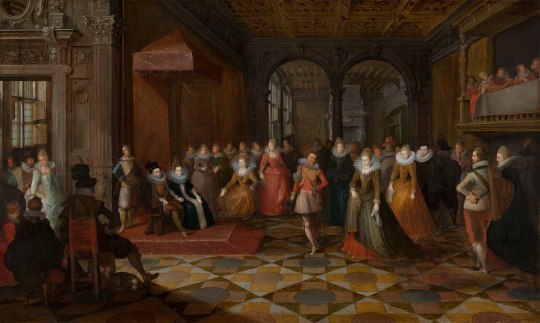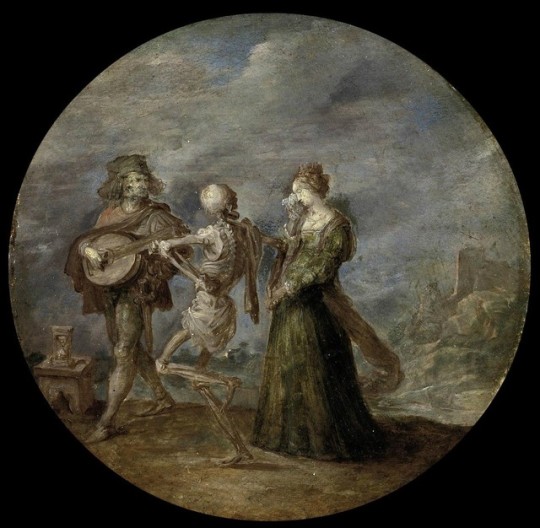#frans Francken the younger
Explore tagged Tumblr posts
Text

Vase with Tulips, Andries Daniels and Frans Francken the Younger, between 1620 and 1625
#art#art history#Andries Daniels#Frans Francken the Younger#still life#floral painting#flowers#tulips#Baroque#Baroque art#Flemish Baroque#Flemish art#17th century art#oil on panel#Bilbao Fine Arts Museum
390 notes
·
View notes
Text

Frans Francken the Younger
#frans francken the younger#last judgement#art#artwork#fine art#fineart#painting#art history#history of art
77 notes
·
View notes
Text

#art#painting#memento mori#dance of death#allegory of avarice#der Tod spielt Geige 1630#frans francken the younger
101 notes
·
View notes
Text

Landscape with Allegories of the Four Elements by Jan Brueghel the Younger (figures) and Frans Francken the Younger (landscape)
Flemish, 1635
oil on panel
J. Paul Getty Museum
#landscape#allegory#elements#art history#Jan Brueghel the Younger#Frans Francken the Younger#Flemish#art#painting#Getty Museum#J. Paul Getty Museum
45 notes
·
View notes
Text

Gathering of Witches, Frans Francken the Younger, 1607
#gathering of witches#witches#witch#frans francken#frans Francken the younger#francken#1607#1600s#17th century#art#painting
32 notes
·
View notes
Text

Christ on the Road to Calvary, Follower of Frans Francken the Younger
21 notes
·
View notes
Text

Frans Francken the Younger (Flemish, 1581–1642) • Chamber of Art and Curiosities • 1636
#art#painting#fine art#art history#still life#oil painting#frans francken the younger#baroque still life#flemish artist#17th century european art#art of the still life blog#collection still life#art blogs on tumblr#art lovers on tumblr
46 notes
·
View notes
Text

The Triumph of Neptune and Amphitrite by Frans Francken the Younger
#frans francken the younger#art#neptune#amphitrite#roman mythology#greek mythology#roman religion#mythology#religion#mythological#roman#ancient rome#antiquity#ancient greece#ancient greek#europe#european#classical#gods#goddess#mythical creatures#triton#merman#mermaid#nereids#mermaids#trident#chariot
58 notes
·
View notes
Text

The Witches' Kitchen (1606) by Frans Francken the Younger
#art#traditional art#oil painting#painting#fine art#classical art#dark aesthetic#dark art#gothic#dark academia#witch#witches#witchcraft#barroque#Frans Francken the Younger
49 notes
·
View notes
Text

Ballroom Scene at a Court in Brussels by Frans Francken the Younger and Paul Vredeman de Vries, 1610.
#classic art#painting#frans francken the younger#paul vredeman de vries#flemish artist#17th century#baroque#genre art#royal court#society scene#people#palatial interior#hall
43 notes
·
View notes
Text

Death and the Merchant
Artist: Frans Francken the Younger (Flemish, 1581–1642)
Date: 17th Century
Medium: Oil on Copper
Collection: Private Collection
Description
The old man rests his foot on a stool, perhaps as a relief from gout, the disease of the wealthy and self indulgent which affected the toes, and he points to it in awareness that death and disease will inevitably catch up with him. The skeleton, in mocking imitation, rests its own foot on an hourglass, a common symbol of the transience and the sands of life running out. He spots an embroidered purse at his waist containing an object hard to decipher but maybe a shovel for scooping up the money that will be of little avail to the man once he is dead. In the background another skeleton confronts a much younger man, perhaps the older man’s son, who through his father's wealth and judging by his sword has elevated himself to the gentry class. He may be in a position to dissipate his father's riches, but death always lies in wait.
#painting#oil on copper#merchant#death#skeleton#indoor#table#hourglass#embroidered purse#man#foot stool#wealth#frans francken the younger#european art#17th century#violin#decor
11 notes
·
View notes
Text

Christ and the Woman Taken in Adultery
Artist: Frans Francken the Younger (Flemish, 1581-1642)
A Woman Caught in Adultery | John 8:1-11, New Living Translation
Jesus returned to the Mount of Olives, but early the next morning he was back again at the Temple. A crowd soon gathered, and he sat down and taught them. As he was speaking, the teachers of religious law and the Pharisees brought a woman who had been caught in the act of adultery. They put her in front of the crowd. “Teacher,” they said to Jesus, “this woman was caught in the act of adultery. The law of Moses says to stone her. What do you say?” They were trying to trap him into saying something they could use against him, but Jesus stooped down and wrote in the dust with his finger. They kept demanding an answer, so he stood up again and said, “All right, but let the one who has never sinned throw the first stone!” Then he stooped down again and wrote in the dust. When the accusers heard this, they slipped away one by one, beginning with the oldest, until only Jesus was left in the middle of the crowd with the woman. Then Jesus stood up again and said to the woman, “Where are your accusers? Didn’t even one of them condemn you?” “No, Lord,” she said. And Jesus said, “Neither do I. Go and sin no more.”
#christianity#biblical#religious art#jesus#woman#gospel of john#new testament#bible story#frans francken the younger#flemish painter#european#17th century painting#classic building#trees#christian art#people
6 notes
·
View notes
Text

Frans Francken the Younger
#frans francken the younger#art#artwork#fine art#fineart#painting#art history#history of art#women in art
11 notes
·
View notes
Photo

#orpheus and eurydice#danse macabre#dance of death#frans francken ii#frans francken the younger#gerrit van battem#hans holbein
280 notes
·
View notes
Text

Church Interior (17th century, oil on panel) | Frans Francken II, Pieter Neeffs I
#art#fine art#painting#oil painting#17th century#church interior#frans francken the younger#pieter neeffs#architecture
15 notes
·
View notes
Text

Witches' Sabbath, Frans Francken the Younger, 1606
#witches' sabbath#frans Francken the younger#frans francken#francken#1606#1600s#17th century#painting#art#witches
11 notes
·
View notes